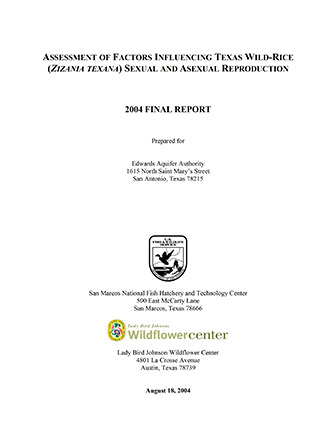Assessment of Factors Influencing Texas Wild-Rice (Zizania texana) Sexual and Asexual Reproduction

| Author | P Power (San Marcos National Fish Hatchery and Technology Center) and FM Oxley (Lady Bird Johnson Wildflower Center) |
| Year | 2004 |
| Description | Laboratory and field studies on critical determinants of reproduction in Texas Wild-Rice (Zizania texana) |
| Publisher | San Marcos National Fish Hatchery and Technology Center and Lady Bird Johnson Wildflower Center |
| Location | San Marcos River |
| Cover | View Download |
| File | View Download |
| Summary |
|
The purpose of this study was to identify factors that influence sexual and asexual reproduction of Texas Wild-rice (Zizania texana). Data collected during the study were used to examine the characteristics of pollen viability and dispersal, stigma viability, ability to self-pollinate, seed production and quality, minimum distances for successful pollination within and among stands, and asexual output. New information regarding pollination success and seed production for Texas Wild-rice was documented. The study was completed in June 2004 by the U.S. Fish and Wildlife – San Marcos National Fish Hatchery and Technology Center and the Lady Bird Johnson Wildflower Center. [Excerpted from the Executive Summary] The combined information in the chapters of this report creates a description of the reproductive biology of Z. texana. Pollen is released during the relatively cool morning hours (between 0200 and 0400) and is short lived ( |
Search for Documents
Advance Search
Explore EAA's Scientific Reports
- All Reports
- Groundwater Movement
- Geomorphology and Caves
- Weather Modification
- Geology
- Water Use and Conservation
- Geochemistry
- Water Resources Planning and Management
- Floods and Drought
- Water Quality
- Climatology
- Surface Water / Groundwater Relationship
- Biology
- Springs, Groundwater Discharge
- Archaeology
- RZ Protection
- Aquifer Levels
- Remote Sensing
- Precipitation
- Overview Studies
- Modeling
- Hydrology and Hydrogeology
- History
- Groundwater Recharge, Recharge Zone
